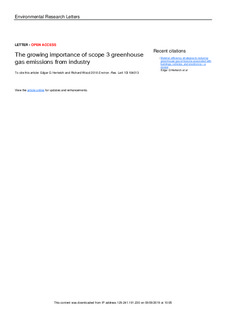| dc.description.abstract | Carbon reporting is increasingly focussing on indirect emissions that occur in the supply chain of establishments. The GHG protocol, a corporate standard, distinguishes scope 2 (emissions associated with electricity consumption) and scope 3 (emissions associated with other inputs), in addition to scope 1 emissions (occurring directly at the facility or company in question). However, the magnitude and growth trajectory of scopes 2 and 3 emissions at the economy-wide level is unknown. Here we conduct an input–output investigation of indirect carbon dioxide (CO2) emissions for the global economy organized in five sectors—energy supply, transport, industry, buildings, and agriculture and forestry—as defined by the Intergovernmental Panel on Climate Change (IPCC). In comparison to previous work that looks at indirect emissions of consumption, we present the first economy-wide analysis of indirect emissions of gross production. The goal of the work is thus to capture the potential agency different sectors have over supply chain emissions, rather allocating emissions between production and consumption. Between 1995 and 2015, global scopes 1, 2, and 3 emissions grew by 47%, 78%, and 84%, to 32, 10, and 45 Pg CO2, respectively. Globally, the industry sector was most important with scope 2 emissions of 5 Pg and scope 3 emissions of 32 Pg. For buildings, scope 3 emissions of 7 Pg were twice as high as direct emissions. Industry and buildings stood in marked contrast to energy and transport, where direct emissions accounted for >70% of total emissions responsibility. Most of the growth happened in developing countries. The proposed analysis scheme could improve the integration of sector chapters in future IPCC reports. | nb_NO |

